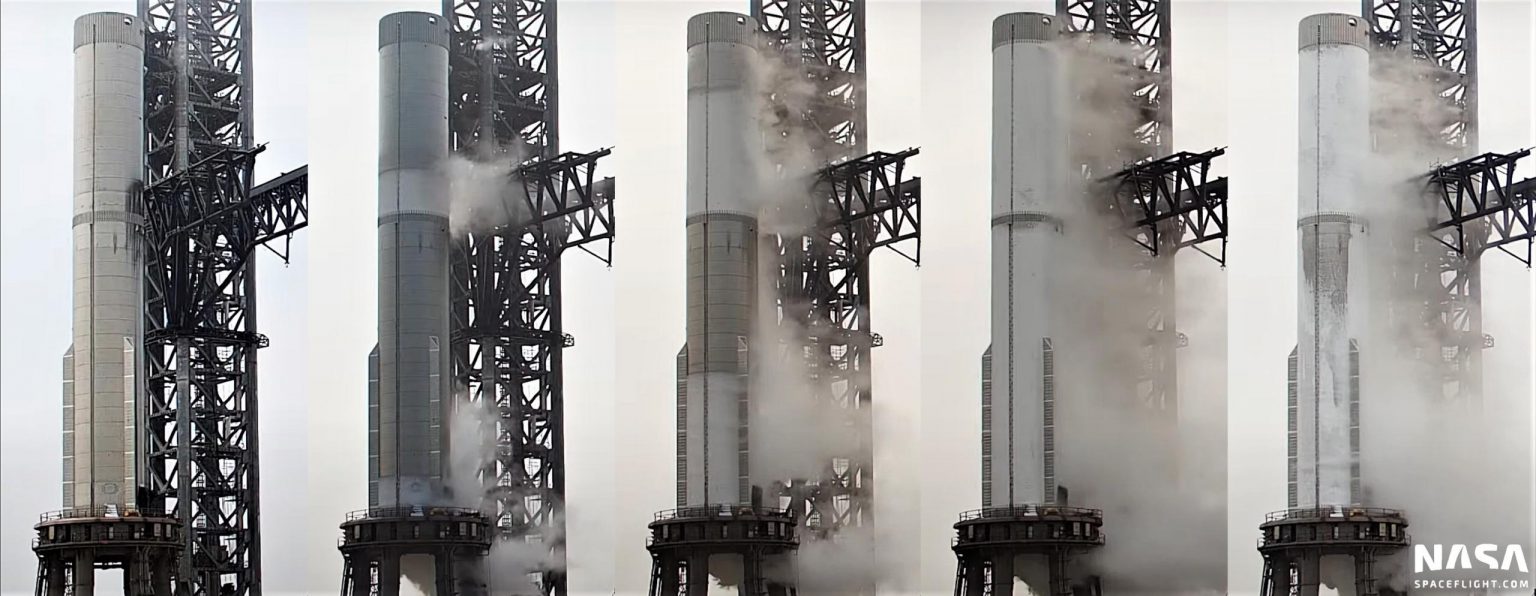SpaceX modified Super Heavy rocket passes its first major test with flying colours.

SpaceX's first updated 33-engine Super Heavy rocket looks to have breezed through a critical test, boding well for a trouble-free qualification process.
Attempting that test so soon after launch did not appear to be part of SpaceX's original plan. Rather than that, shortly before Super Heavy Booster 4 was removed from Starbase's "orbital launch mount" (OLM) for the third and likely final time on March 24th, SpaceX transported a massive structural test stand from a Starbase storage yard to the orbital launch site (OLS), where technicians have concentrated on modifying nearby ground systems to support apparent structural testing of Super Heavy Booster 7. As of March 31, all the information available said that SpaceX was building that stand to test Booster 7's mechanical strength and replicate the main stresses it will face during qualification testing before spending a lot of time and money on qualification testing.
SpaceX, on the other hand, appeared to alter its plans at the last minute.
Advertisement
Rather than begin with structural testing, SpaceX wheeled Super Heavy B7 into place and craned the massive booster onto the orbital launch pad on April 2nd, following a brief two-day break. On April 3rd, the "rapid disconnect" device on the launch mount connected Super Heavy to the pad's ground infrastructure. On April 4th, less than two days after being installed on the OLM, Super Heavy B7 began the first of a series of qualification tests that will determine when, if ever, the booster will enable Starship's first orbital launch attempt.
If all tests go well, SpaceX CEO Elon Musk recently claimed that Starship and Super Heavy – most likely Ship 24 and Booster 7 – might be ready for their first orbital launch as early as May 2022. SpaceX appears to have jumped headfirst into Super Heavy Booster 7 qualification testing, considerably increasing the probability of reaching that highly aggressive deadline. Normally, with a first-of-its-kind prototype introducing numerous substantial design changes, SpaceX would begin slowly, maybe with a simple pneumatic proof test to establish structural integrity at flight pressures – approximately 6.5–8.5 bar (95–125 psi) – using benign nitrogen gas.
With Booster 7, SpaceX very certainly conducted a brief pneumatic test, but then quickly moved on to a full-scale cryogenic test. SpaceX, for example, conducted many increasingly ambitious cryogenic proof tests on Super Heavy B4, gradually filling the booster to capacity but never completely. On the first day of testing and the first cryogenic proof attempt for Booster 7, SpaceX completely loaded the upgraded Super Heavy with a cryogenic fluid (presumably liquid nitrogen) in less than two hours – all without any substantial unplanned holds (pauses).
SpaceX is estimated to have loaded approximately 3400 metric tonnes (7.5 million pounds) of liquid nitrogen (LN2) into Super Heavy B7's liquid methane (LCH4) and oxygen (LOx) tanks during those two hours-a figure that is close to what Super Heavy would weigh at liftoff. At its height, Booster 7 was almost totally covered in a thin layer of ice formed when the cryogenic liquid inside its tanks froze water vapour in the humid South Texas air onto its skin — a process that basically transforms uninsulated cryogenic rockets into huge fill gauges. Apart from encountering no apparent complications, the first cryogenic proof of Super Heavy B7 also marks the first time any Super Heavy prototype has been entirely filled during testing—a significant milestone for any rocket prototype, let alone the world's heaviest rocket booster.
Advertisement

Booster 7's accomplishment of successfully completing a full cryogenic proof test on its first attempt is very uncommon among all starship prototypes, not just Super Heavies. The comparison to Booster 4, which conducted only a few partial cryogenic proof tests during its more than half-year stay at Starbase's orbital launch site, is also incredibly promising, indicating that Booster 7 will not sit idle for months at a time.
Nonetheless, cryogenic proofing is just one of several critical tests that Booster 7 must pass. Even if SpaceX does not attempt additional cryoproofs with higher tank pressures or other modified factors, Super Heavy B7 must complete wet dress rehearsal testing (WDR) with combustible LCH4/LOx propellant and demonstrate autogenous pressurisation (using heated propellant gas to pressure its tanks). At some point, SpaceX will also need to put all 33 Raptor V2 engines on the booster and heat-shield the entire engine area and each Raptor.

Booster 4’s 29 partially shielded Raptor engines. (Starship Gazer)

B4’s fully shielded engine section. (NASASpaceflight)

At the moment, B7 has no Raptors and no shielding installed. (NASASpaceflight – bocachicagal)
Depending on the availability of Raptor V2 engines, SpaceX may begin static fire testing with only a few fitted and shielded engines and then add the remaining engines and heat shield later. On the other hand, conducting static fires without a complete heat shield may result in damage to uncovered cabling or other subsystems, in which case wet dress rehearsal testing would likely occur immediately following cryoproofing and prior to engine or shield installation. After being overlooked, the structural test stand may now be considered for Booster 7 qualification prior to engine installation.
While there is still considerable uncertainty, Super Heavy B7's promising start indicates that the Booster 4 experience is far from a blueprint and that SpaceX is considerably less eager to waste time this time around.
Advertisement